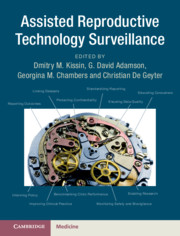Book contents
- Frontmatter
- Contents
- Foreword
- List of Contributors
- Section 1 Introduction to ART Surveillance
- Section 2 General Principles of ART Surveillance
- Section 3 Using ART Surveillance Data
- Section 4 Global Variations in ART Surveillance
- 11 Global ART Surveillance: The International Committee Monitoring Assisted Reproductive Technologies (ICMART)
- 12 Global Variations in ART Policy: Data from the International Federation of Fertility Societies (IFFS)
- 13 ART Surveillance in Africa
- 14 ART Surveillance in Asia
- 15 ART Surveillance in Australia and New Zealand
- 16 ART Surveillance in Europe
- 17 ART Surveillance in the Middle East: Governance, Culture and Religion
- 18 ART Surveillance in North America
- 19 ART Surveillance in Latin America
- Section 5 Surveillance of Non-ART Fertility Treatments
- Appendix A ART Surveillance System Variables and Definitions
- Appendix B International Glossary on Infertility and Fertility Care
- Appendix C ICMART Data Collection Form
- Index
- Plates
14 - ART Surveillance in Asia
from Section 4 - Global Variations in ART Surveillance
Published online by Cambridge University Press: 14 June 2019
- Frontmatter
- Contents
- Foreword
- List of Contributors
- Section 1 Introduction to ART Surveillance
- Section 2 General Principles of ART Surveillance
- Section 3 Using ART Surveillance Data
- Section 4 Global Variations in ART Surveillance
- 11 Global ART Surveillance: The International Committee Monitoring Assisted Reproductive Technologies (ICMART)
- 12 Global Variations in ART Policy: Data from the International Federation of Fertility Societies (IFFS)
- 13 ART Surveillance in Africa
- 14 ART Surveillance in Asia
- 15 ART Surveillance in Australia and New Zealand
- 16 ART Surveillance in Europe
- 17 ART Surveillance in the Middle East: Governance, Culture and Religion
- 18 ART Surveillance in North America
- 19 ART Surveillance in Latin America
- Section 5 Surveillance of Non-ART Fertility Treatments
- Appendix A ART Surveillance System Variables and Definitions
- Appendix B International Glossary on Infertility and Fertility Care
- Appendix C ICMART Data Collection Form
- Index
- Plates
Summary
Australia established the first national ART registries in the world in 1983, collating treatment and outcome data on the just over 200 pregnancies achieved in Australia from IVF. New Zealand clinics soon followed, contributing data to the registry in 1984. The registry, now known as the Australian and New Zealand Assisted Reproductive Technology Database (ANZARD), is an example of successful cooperation and collaboration between clinicians, fertility clinics, universities and regulators. Under a fertility clinic’s licensing agreement all ART treatment cycles are required to be report to ANZARD, ensuring complete ascertainment is achieved. The data from the registry have been publicly reported without interruption on an annual basis by the National Perinatal Epidemiology and Statistics Unit (NPESU), formally the NPESU for over 30 years, and made widely available to consumers, policy makers and researchers. The ANZARD annual report includes over 80 descriptive tables including age-specific success rates from successive treatment cycles. One of ANZARD’s important achievements has been in supporting the fertility sector in Australia and New Zealand to reduce the multiple birth rate to become one of the lowest in the world, with rates consistently below 5%. ANZARD continues to evolve towards more automated data collection and reporting platforms, and periodic changes to the data dictionary to accommodate changing patient demographics, and scientific and clinical practice.
Keywords
- Type
- Chapter
- Information
- Assisted Reproductive Technology Surveillance , pp. 133 - 141Publisher: Cambridge University PressPrint publication year: 2019



